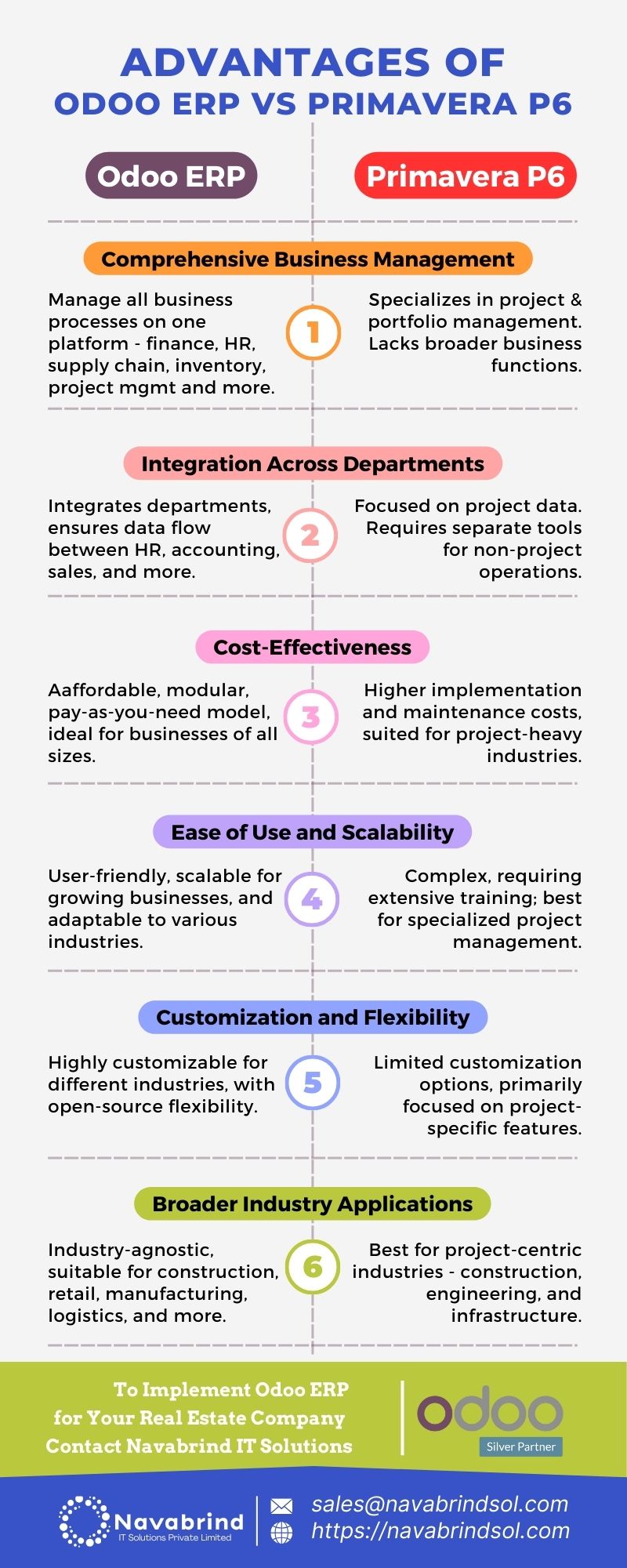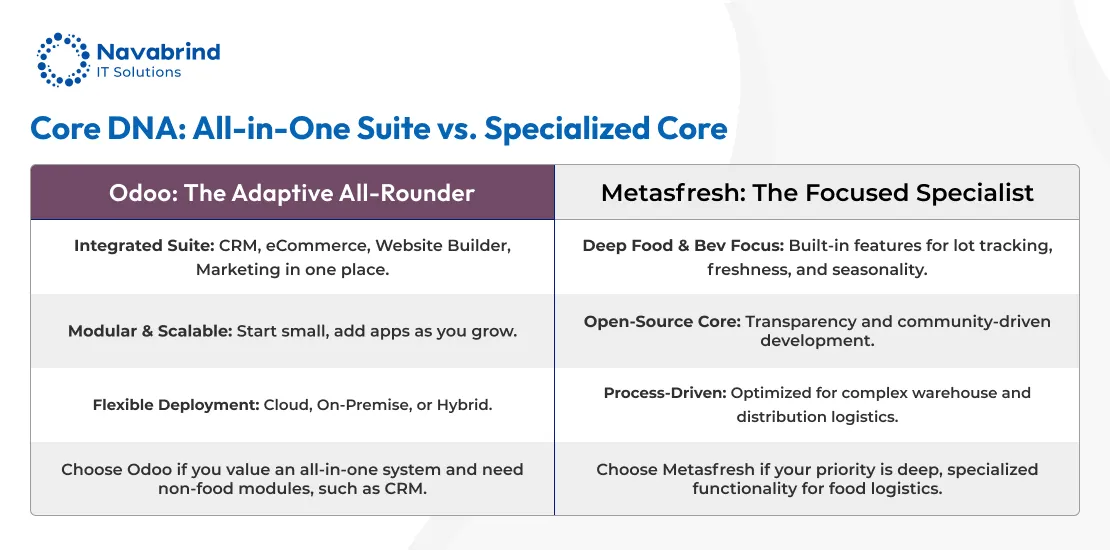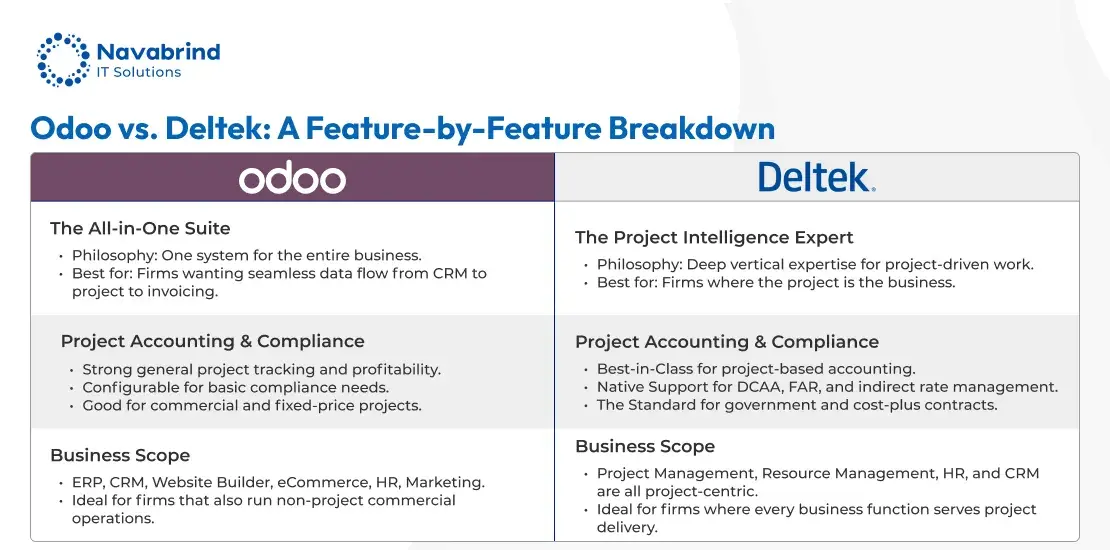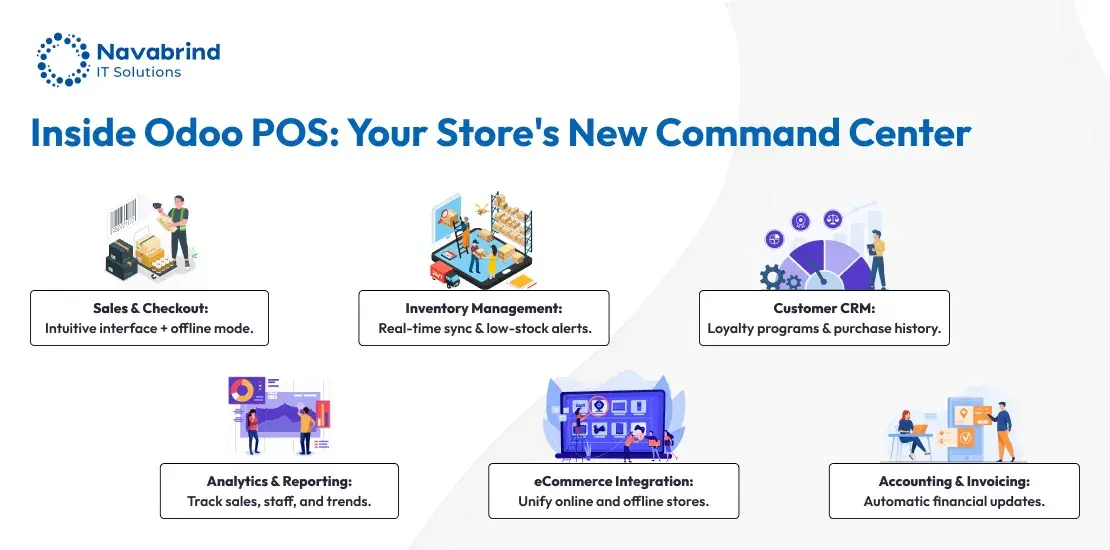Odoo ERP v/s Primavera P6 EPPM
- September 17, 2024
- Posted by: Tony
- Categories: Blog, Odoo

In the realm of enterprise software, the two tools that are often compared are Enterprise Resource Planning (ERP) systems and Enterprise Project Portfolio Management (EPPM). While they share the goal of improving organizational efficiency, they differ in scope, focus, and functionality. Understanding the difference between the two software helps businesses choose the right solution.
Definition and Purpose
ERP: An ERP system is designed to integrate and manage the core business processes of an organization across departments such as finance, human resources, manufacturing, procurement, CRP, inventory, logistics, warehousing, marketing, sales and more. The primary goal of an ERP is to provide a unified system where all the departments in an organization can access shared data and streamline operations. ERPs are holistic, cross-functional systems that optimize business resources and workflows, enabling more efficient management of a company’s resources and operations.
EPPM: Enterprise project and portfolio management are focused on enabling organizations to manage and oversee multiple projects, ensure they align with strategic business goals, and optimize resource allocation. EPPM tools emphasize project execution, tracking, and reporting, providing businesses with insight into project timelines, budget usage, resource availability, and overall project performance. EPPM software is crucial for industries that deal with complex, overlapping projects, such as construction, engineering, IT, and R&D.
Key Functionalities of ERP and EPPM
ERP: ERP systems functionalities span across the following core business areas:
- Finance and Accounting: Automated invoicing, financial reports, budget tracking, and cash flow management.
- Human Resources (HR): Employee data management, payroll processing, benefits administration, and performance reviews.
- Supply Chain and Inventory Management: Real-time tracking of raw materials, production scheduling, procurement, and distribution.
- Customer Relationship Management (CRM): Managing customer data, sales forecasts, and lead tracking.
- Manufacturing and Production: Managing production schedules, resource allocation, and quality control.
ERP systems are essential for businesses that need to optimize end-to-end business operations and want to avoid siloed data across departments. By having a single system, the ERP promotes better communication and collaboration across departments.
EPPM: EPPM tools provide project-focused functionalities such as:
- Project Planning and Scheduling: Gantt charts, task assignment, resource allocation, and project timelines.
- Portfolio Management: Prioritization of projects based on business objectives, risks, and resource availability.
- Risk and Issue Management: Identifying and mitigating project risks, ensuring compliance, and resolving project issues.
- Resource Management: Allocation and optimization of human and financial resources across multiple projects.
- Time and Cost Tracking: Monitoring project budgets, actual vs. planned costs, and timelines to avoid overruns.
- Performance Reporting: Dashboards and key performance indicators (KPIs) to monitor the health of projects and portfolios.
EPPM software is ideal for organizations focused on project-driven initiatives, enabling project managers and teams to deliver successful projects on time and within budget.
Scope and Focus
ERP’s Scope: An ERP system is designed to serve as a backbone for the entire business. It covers a broad scope, integrating multiple departments and their workflows into a single system. The focus is on business process optimization—automating and managing financials, human resources, procurement, manufacturing, and more. ERP is necessary when a company needs a comprehensive solution for tracking its entire business operation, providing visibility and control over its resources.
EPPM’s Scope: EPPM tools have a narrower scope but a more specialized focus. They cater specifically to the management of projects and portfolios, ensuring that resources are allocated optimally across projects and that projects align with the organization’s strategic goals. Unlike ERPs, which handle day-to-day operations, EPPM tools focus on project execution and strategic alignment. They ensure that projects are completed on time, within budget, and deliver value to the business.
Integration vs. Specialization
ERP Integration: ERP systems are all about integration. They are designed to break down silos within a company, ensuring that data flows seamlessly between departments. For example, inventory data from the supply chain module can trigger procurement actions, or sales data can automatically update financial forecasts. The primary strength of an ERP lies in its ability to unify various functions of a business into a single, integrated system.
EPPM Specialization: EPPM tools, in contrast, are specialized solutions. While they can be integrated with ERP systems, their core focus remains on providing granular visibility into projects and portfolios. EPPM tools may not handle finance or HR functions on their own but instead focus on how resources (both human and financial) are allocated and managed across projects. An EPPM tool might pull financial data from an ERP system to track project budgets but does not handle accounting for the entire business.
Target Users
ERP Users: ERP systems are used by a wide range of roles within a company, from C-level executives to department heads and operational staff. Because ERP systems touch all facets of an organization, users from finance, HR, procurement, manufacturing, supply chain, warehousing, sales, IT, and others, regularly interact with the system. Its end-to-end functionality makes it crucial for organizations that require an overarching view of their operations.
EPPM Users: EPPM tools are mainly used by project managers, portfolio managers, and executives who oversee project execution and strategic alignment. These users rely on EPPM systems to ensure that projects are within budget and schedule, managing risk, are managing resources efficiently, have procurement under control, delivering to expected ROI and business goals. EPPM tools are critical for organizations where project performance is a key driver of business success, such as in construction, IT, or R&D.
Use Cases
ERP Use Cases: ERPs are suitable for organizations that need to streamline their core business processes across departments. Common industries using ERP include:
- Manufacturing: To manage production schedules, inventory, and supply chain.
- Retail: For tracking sales, inventory, and supply chain.
- Healthcare: To manage patient records, billing, and inventory.
ERPs are indispensable for any organization that needs to unify their operations and gain real-time visibility into every aspect of their business.
EPPM Use Cases: EPPM tools are indispensable in project-intensive industries where the focus is on delivering complex projects on time and within budget. Typical use cases include:
- Construction: Managing large-scale infrastructure projects with multiple teams and dependencies.
- IT Services: Overseeing the implementation of software development projects and tracking progress across multiple clients.
- R&D: Prioritizing projects based on research potential, resource availability, and business goals.
Is it time for the Construction Industry to think Bigger and transition from PPM software like Primavera P6 EPPM to Odoo ERP
The construction industry has long relied on project portfolio management (PPM) tools like Primavera P6 EPPM to handle complex projects. Primavera’s robust project scheduling and resource management capabilities make it a popular choice for large-scale construction projects, especially in sectors like infrastructure and real estate development. However, as the construction industry evolves, so too must its approach to technology.
With increasing project complexity, tighter margins, and the need for integrated operations, Odoo ERP presents a powerful alternative to traditional PPM tools. Unlike Primavera, which focuses solely on project management, Odoo offers a comprehensive enterprise resource planning (ERP) system that integrates project management with financials, procurement, HR, and other critical business functions. For construction companies looking to streamline operations, improve efficiency, and gain a competitive edge, it’s time to think bigger and transition from PPM software like Primavera P6 EPPM to Odoo ERP. Here’s why
1. Comprehensive Business Management vs. Project Focus
One of the most significant differences between Primavera P6 EPPM and Odoo ERP is the scope of functionality. Primavera is highly specialized in project portfolio management, offering advanced features for scheduling, resource allocation, and risk management. While these capabilities are invaluable for managing complex construction projects, they are limited in scope. Primavera focuses exclusively on projects, leaving other essential business functions like accounting, procurement, and human resources outside its purview.
Odoo ERP is a comprehensive business management platform that integrates project management with all other core business functions. This integration is especially important for construction companies, where project success is closely tied to financial management, vendor relationships, and workforce optimization. Odoo’s modular design allows construction firms to manage not only their projects but also every other aspect of their business from a single platform.
By transitioning to Odoo, construction companies can move beyond siloed project management and achieve a more holistic view of their operations. This leads to better decision-making, improved resource allocation, and more efficient processes.
2. Better Integration Across Departments
Construction projects are inherently complex, involving coordination between various departments like procurement, HR, finance, and project management. Primavera P6, while effective for managing project timelines and resources, lacks the ability to integrate these departments. This often leads to the creation of separate systems for each function, resulting in data silos and inefficient workflows.
Odoo ERP solves this problem by providing a fully integrated solution where all departments can collaborate seamlessly. Whether it’s tracking inventory for construction materials, managing vendor contracts, or overseeing payroll for workers, Odoo ensures that every department has access to real-time information. This level of integration reduces redundancy, eliminates errors, and improves overall efficiency.
For example, if there’s a delay in material procurement, the project manager can see the impact on the project timeline and adjust accordingly. Similarly, the finance team can track project costs in real-time, ensuring that the project stays within budget. This cross-departmental integration is crucial for construction companies looking to improve communication, optimize resources, and deliver projects more efficiently.
3. Cost Efficiency
Cost is always a significant consideration for construction companies, especially in today’s competitive market. Primavera P6 is known for being an expensive tool to implement and maintain, particularly for small and medium-sized enterprises (SMEs). The software requires not only significant upfront investment but also ongoing costs for licensing, maintenance, and specialized training.
In contrast, Odoo ERP is known for its affordability and flexibility. Odoo’s modular pricing model allows companies to only pay for the functionalities they need, making it accessible for businesses of all sizes. Additionally, Odoo’s open-source nature means companies can customize the software to fit their specific needs without incurring exorbitant costs.
By transitioning to Odoo, construction companies can not only gain access to a broader range of functionalities but also reduce overall software costs, making it a more cost-effective solution compared to Primavera P6.
4. Improved Scalability and Flexibility
Construction projects vary greatly in size and complexity, requiring software that can scale alongside the company’s growth. While Primavera P6 is well-suited for managing large-scale projects, it is less flexible when it comes to adapting to smaller projects or handling non-project-related business functions.
Odoo ERP, on the other hand, is highly scalable and flexible. Companies can start with the core modules they need and gradually expand the system as their business grows or as new needs arise. Whether a company needs to add more advanced project management tools, financial forecasting, or human resources management, Odoo can be easily customized and scaled to meet these requirements. This adaptability makes Odoo ideal for construction companies that handle projects of varying sizes or plan to expand their operations over time.
5. Enhanced Data Visibility and Reporting
Data-driven decision-making is critical for the success of any construction project. However, Primavera P6 provides limited visibility into non-project-related data, which can make it difficult for construction firms to get a complete picture of their business performance. For instance, financial data, procurement details, and employee performance metrics often need to be accessed through separate systems, leading to fragmented reporting and delayed decision-making.
Odoo ERP offers real-time visibility into every aspect of the business, from project progress and financials to inventory levels and workforce management. Its customizable dashboards and detailed reporting tools provide construction companies with a 360-degree view of their operations.
6. Streamlined Processes and Automation
Construction companies are under constant pressure to complete projects on time and within budget. Manual processes and disjointed systems can slow down operations and increase the risk of errors. Primavera P6, while excellent for managing projects, does not provide the automation and process streamlining capabilities that Odoo ERP offers.
With Odoo, construction companies can automate repetitive tasks like invoice generation, payroll processing, and inventory tracking, freeing up valuable time for more strategic activities. This automation reduces the risk of human error, accelerates project timelines, and improves overall efficiency.
Still wondering whether Odoo ERP is the right choice for you? Want to have a detailed discussion on why Odoo ERP is better suited for the construction industry? Drop us a note.
Explore how your construction company can leverage the powerful Odoo ER. Navabrind IT Solutions can help you
If you’re looking to modernize your construction company’s operations, reach out to Navabrind IT Solutions. As an Odoo Silver Partner, we specialize in implementing Odoo ERP for businesses like yours. We understand the unique challenges faced by the construction industry—tight deadlines, complex resource needs, huge procurements and vendor management, complex finances, and fluctuating budgets—and can tailor Odoo’s modules to meet your specific requirements. Whether it’s managing contracts, tracking inventory, optimizing procurement, or ensuring compliance with industry regulations, Navabrind IT Solutions will help you leverage Odoo ERP to its fullest potential.
Our team of experts provides end-to-end Odoo ERP implementation, including consulting, implementation, customization, integration, training, and support. With our guidance, you’ll be able to improve project efficiency, reduce costs, and gain real-time insights into your operations.
Ready to unlock the power of Odoo ERP for your construction company? Navabrind IT Solutions is here to help you get started. Email us at [email protected] to schedule a free consultation on Odoo ERP, today.
Schedule a conversation with us now!
Related Articles
-
Post
Odoo ERP vs. Metasfresh – Choosing the Right Fit for Your Food Business
Odoo ERP vs. Metasfresh – Choosing the Right Fit for Your Food Business December 22, 2025 Posted by: Tony Categories: Blog, Odoo ERP vs. Metasfresh No Comments In the competitive, regulated food industry, the right ERP isn’t a luxury—it’s the operational backbone of your entire business. It’s the system that manages your critical tasks: tracking -
Post
Odoo ERP vs. Deltek – Which ERP Fits Your Architecture, Engineering, Construction, or Consulting Firm?
Odoo ERP vs. Deltek – Which ERP Fits Your Architecture, Engineering, Construction, or Consulting Firm? December 11, 2025 Posted by: Tony Category: Odoo ERP vs Deltek No Comments Why Architecture, Engineering, Construction (AEC), and Consulting Industries Need ERP Systems ERP systems have become indispensable tools for Architecture, Engineering, Construction, and Consulting firms, which handle multi-faceted -
Post
Streamline Your Store: A Deep Dive into the Odoo Point of Sale System
Streamline Your Store: A Deep Dive into the Odoo Point of Sale System December 5, 2025 Posted by: Tony Category: Uncategorized No Comments The Heart of the Modern Retail Experience Picture this: a customer walks into your store, finds what she is looking for and is ready to buy. Your online store just received five
How can we help you?
Get in touch with a solutions consultant that can share best practices and help solve specific challenges.









